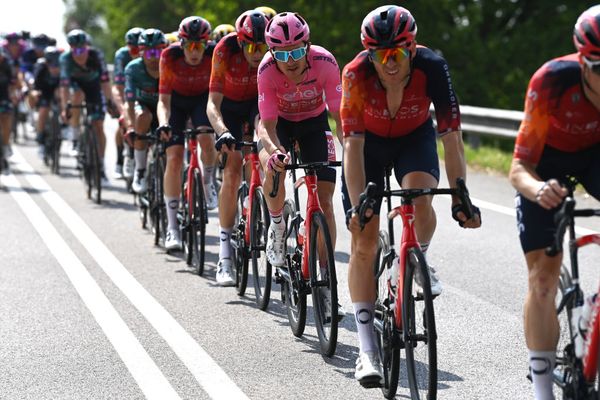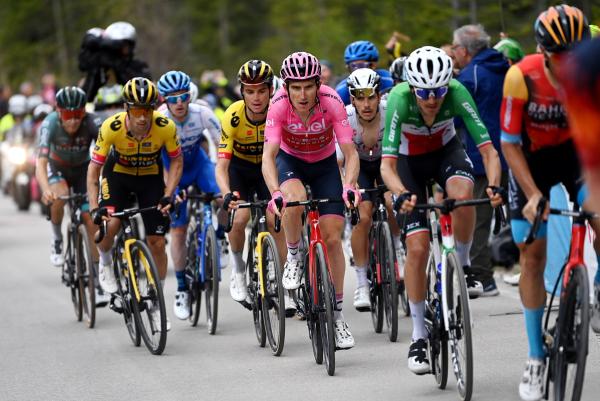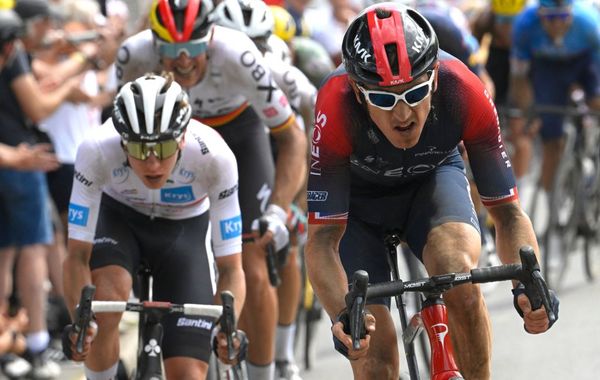Giro d'Italia: Five key stages that will decide the winner
From the earliest summit finish since 1989 and a lengthy ITT within the first week to a double ascent of the Monte Grappa towards the end, here are the critical days for the pink jersey hopefuls
George Poole
Junior Writer
© Getty Images
The 2024 Giro goes over the famous Stelvio Pass
With the 2024 Giro d'Italia less than a week away and the Spring Classics in the rearview mirror, all attention has firmly turned to who will win the overall title and succeed last year's champion, Primož Roglič, who has his eyes squarely set on the Tour de France in July.
UAE Team Emirates arrive with the outstanding race favourite in Tadej Pogačar, who was in stellar form through the four races he attended in the spring, but the Slovenian won't be without his challengers. Vying for the final podium in Rome and possibly more should Pogačar slip up, Geraint Thomas leads Ineos Grenadiers, Ben O'Connor is spearheading a resurgent Decathlon AG2R La Mondiale and Romain Bardet carries the hopes of dsm-firmenich PostNL.
Read more:
- Giro d'Italia 2024: Essential race preview
- A beginner's guide to the Giro d'Italia
- Eyes on the Giro d’Italia podium for Ben O’Connor: ‘It is a race that really suits me’
With the looming general classification showdown in mind, teams will have long since analysed the route and figured out their best strategies for taking the race to Pogačar. Featuring 68.2km against the clock, being strong in the time trials will be key, but, as ever, there is also plenty of scope for the climbers to make their mark across the six summit finishes.
Here are our five key stages that will decide who wins the 2024 Giro d'Italia.
Earliest summit finish in 35 years could be perfect for Tadej Pogačar
Stage 2: San Francesco al Campo – Santuario di Oropa, 154km

© RCS
Giro d'Italia 2024 stage 2 profile
Stage 2 brings the earliest summit finish seen in the Giro since 1989. The pink jersey will be up for grabs on the steep slopes to the Santuario di Oropa.
At 6.2% for 11.8km, the Oropa is no easy test and will establish a very early pecking order amongst the GC contenders, just as Mount Etna did in 1989 when Acácio da Silva rode to victory. The Oropa itself has history weaved into its bends as well, with Marco Pantani infamously dropping almost 50 riders to win here in 1999 before his failed haematocrit test just a week later.
The last time the Oropa was included, Tom Dumoulin powered to victory ahead of of Vincenzo Nibali and Mikel Landa, on his way to winning the 2017 Giro d'Italia. On that day there were no categorised climbs prior to the Oropa, but Dumoulin's success points to how this year's summit finish may end up – with a powerful rider favoured over a lightweight climber.
The Oropa ascent has an irregular profile to it, with its toughest moments falling in the middle of the climb with kilometres 5-6.5 averaging 9.5%. This section looks ripe for a stinging attack from a rider in the ilk of Tadej Pogačar, i.e. somebody who is noticeably stronger than the other contenders even when everyone is fresh.
Read more: Stat Attack: 8 records to keep Tadej Pogačar from boredom at the Giro d'Italia
Although the final few kilometres of the climb have their tough moments – with a maximum pitch of 14% falling with 2km to ride – the gradient hovers between 5-8% and, should a powerful rider have been able to open a gap on the earlier (and steeper) slopes, this is where they could press home their advantage and sneak an early buffer in the GC standings.
The lightweight climbers may have to wait until later in the race to see their power-to-weight ratio offer them an advantage.
The first ITT will set the tone for the race
Stage 7: Foligno – Perugia, 37.2km (ITT)
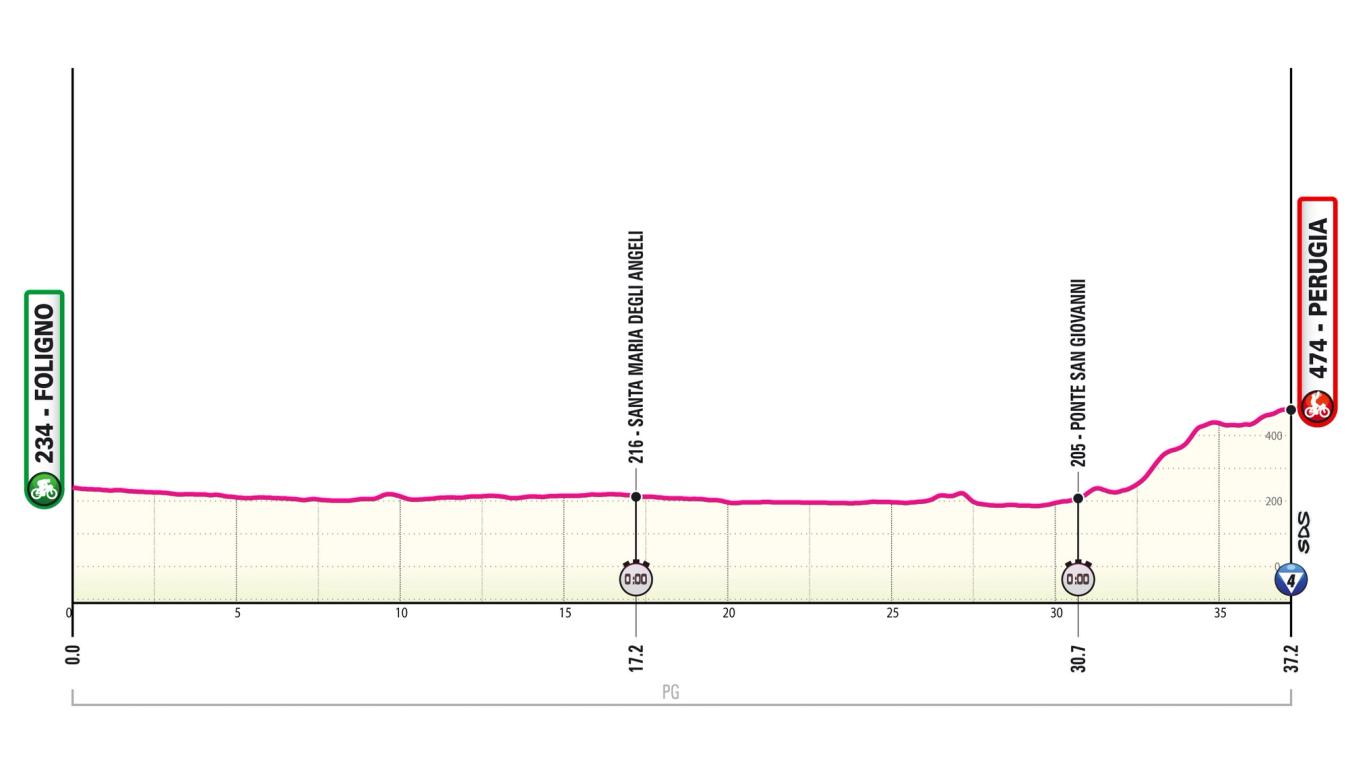
© RCS
Giro d'Italia 2024 stage 7 profile
Although the first two stages of the 2024 Giro d'Italia provide one of the toughest race starts in recent years, the opening week of the race is relatively easy for the GC favourites, with opportunities instead lent to the sprinters and puncheurs. However, their time to shine will come again on stage 7 with the first of two individual time trials of the race.
It is here that the GC standings will take on another reshuffle and decide who needs to go on the offensive in the mountains to make up for any time lost on the time trial bike. At 37.2km long, stage 7 presents a fairly lengthy test by modern expectations, and carries a sting in its tail with a cat-4 climb to conclude proceedings.
Read more: Tadej Pogačar is a bit of a freak but he’s beatable at the Giro d’Italia, says Cummings
The Perugia ascent won't require a bike change by any means, but does contain a steep 1km segment at over 10% and another 800m ramp at 9%, which will certainly tilt the favour ever so slightly the way of a climber who can time trial, rather than a time trialist who can climb - not that there's many of them around these days, anyway.
You can still expect the likes of Thymen Arensman and Geraint Thomas (both Ineos Grenadiers) to be strong here, but the likes of Hugh Carthy (EF Education-EasyPost), Dani Martínez (Bora-Hansgrohe) and Cian Uijtdebroeks (Visma-Lease a Bike) will fancy their chances of limiting their losses over the irregular uphill to the finish.
Time losses here will dictate the mood heading into the hills on stage 8.
Queen stage of the race brings over 5,000m of climbing, but will it happen?
Stage 15: Manebra del Garda – Livigno (Mottolino), 222km
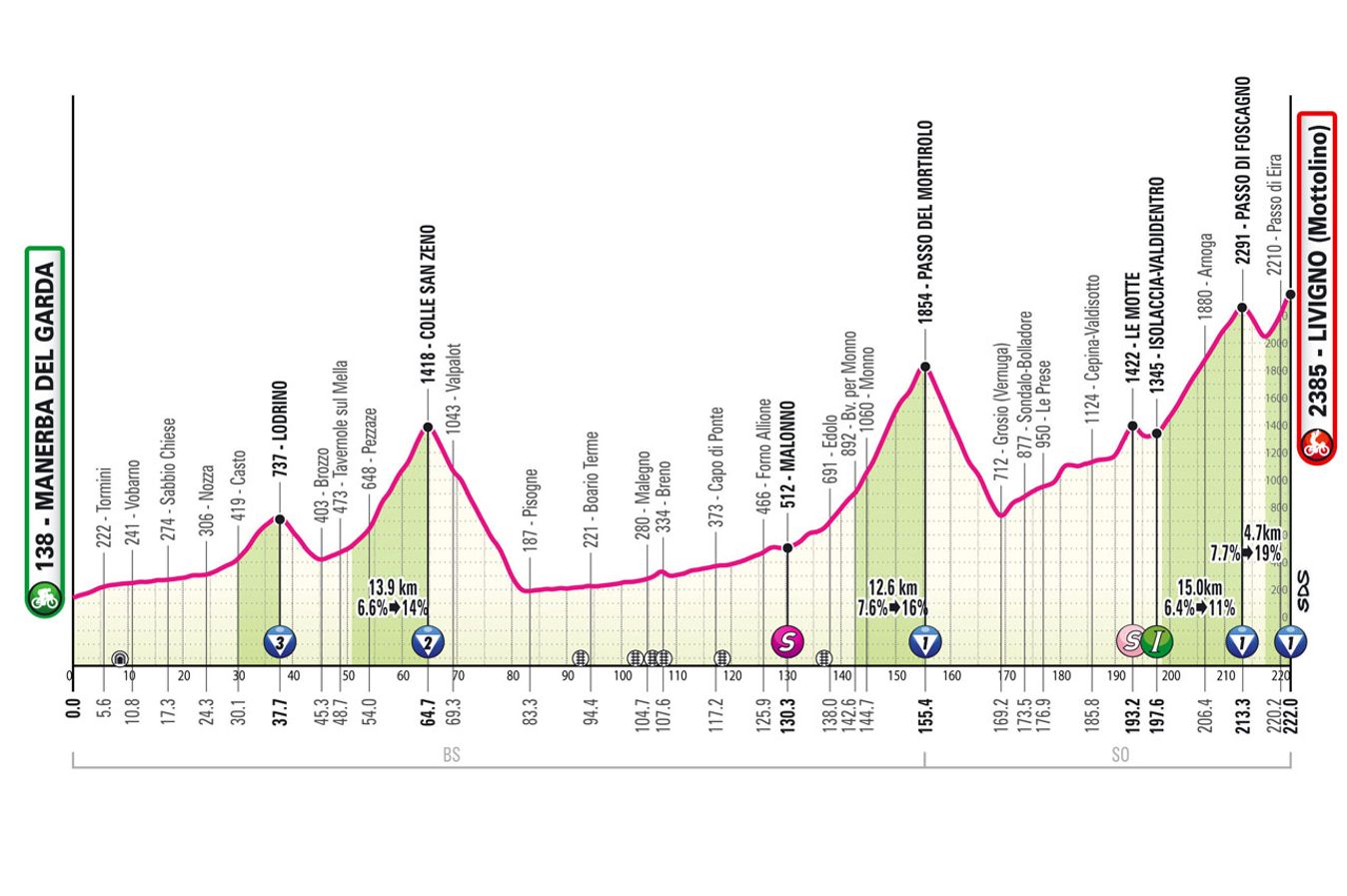
© RCS
Giro d'Italia 2024 stage 15 profile
The longest and toughest day of the 2024 Giro d'Italia falls on stage 15 with what is undoubtedly the Queen stage. Five categorised climbs, 222km and 5,700m of elevation gain await the riders as they traverse from the Italian Alps to the Swiss border via the Colle San Zeno, Passo del Mortirolo and the Passio di Foscagno. Going to above 2,300m altitude, the summit finish comes after the 8.1km-long Mottolino climb.
Given its length and brutality, the contenders for the pink jersey will be forced into action on this day and the fatigue accrued throughout the stage will surely play a part heading into the final two climbs.
With a little over 120km to ride, the riders will take on the 12.6km Passo di Mortirolo, with an average gradient of 7.6%, but sections on 16%. From here, there's a fast descent and then it's back uphill again – uncategorised for nearly 40km before the Passo di Foscagno officially begins.
This climb is the first of the two cat-1 climbs which conclude the day, with both of them finishing at above 2,300m altitude. On paper, it should provide a blockbuster finale to the longest day of the race – the Mottolino extends for 8.1km at 6.6% – but there may be fears for the accessibility of these high-altitude passes should Europe suffer another cold May, and this stage has already been rerouted once.
However, this new route is meant to be more weather-proof, and is perhaps even harder than the original route. Rounding out the second week with a rest day to follow, the GC group should be in tatters by the final 2km that averages over 10%.
A post-rest day treat awaits on the Passo dello Stelvio
Stage 16: Livigno – Santa Cristina Valgardena, 202km

© RCS
Giro d'Italia 2024 stage 16 profile
It is perhaps fears over the snow-capped mountains that have led the Giro organisers to shy away from including the Passo dello Stelvio as anything other than an aperitif on stage 16. The infamous 2,758m high pass will provide a cruel welcome back to the riders following the final rest day, but falling over 100km from the final climbs, its lacklustre inclusion has come to the disappointment of many fans.
That being said, there should still be enough character in the route to draw out another showdown amongst the pink jersey contenders, with the Stelvio serving to create attrition amongst the peloton before the finale.
Following the Cima Coppi of this year's race, it will be on the famous 48 hairpins of the eastern side that the peloton will descend towards the valley. The Val Gardena Dolomites await to the east, beginning with the 23.4km-long Passo Pinei that begins with 35km to ride.
Averaging 4.7%, this little-known ascent is not the steepest of mountains but does hold ramps of up to 15% and will be no easy test given its length. Expect to see a GC team or two setting a high pace from the bottom of this climb in order to string things out ahead of the Monte Pana.
Falling the day after the final rest day, stage 16 packs a punch at over 200km and for any riders coming out of their recovery with wooden legs, there will be no room to hide. The riders who perform well on this summit finish will undoubtedly be those trending in the right direction towards the end of the Giro.
Two ascents of the Monte Grappa will decide the winner of the Giro
Stage 20: Alpago – Bassano del Grappa, 175km
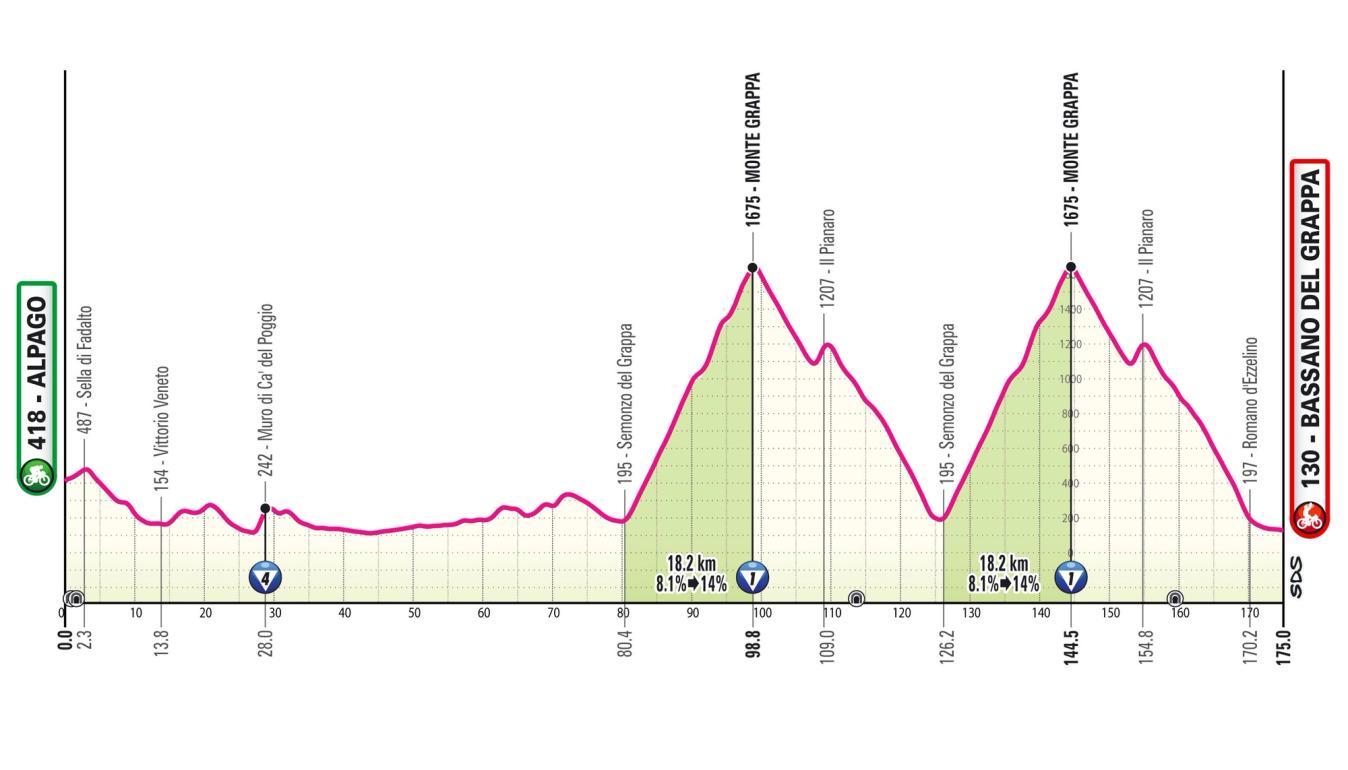
© RCS
Giro d'Italia 2024 stage 20 profile
As has become tradition in the Giro d'Italia, the final stage will be a procession around the streets of Rome, ensuring that the pink jersey battle will be sewn up in advance of stage 21. It will, however, be decided in style with the unprecedented double ascent of the Monte Grappa on stage 20, prior to a lengthy descent to the finish where the winner of the Giro d'Italia will be crowned.
The 80km of undulating roads before the first ascent of the Monte Grappa will likely see a nervous peloton keep any potential breakaway on a tight leash, with just one cat-4 climb to deal with. Traversing the opposite route to when Nairo Quintana conquered the Monte Grappa in the 2014 edition – albeit in an individual time trial – the peloton will tackle the Monte Grappa from Treviso.
At 8.1% for 18.2km, the Monte Grappa has not been used often in the Giro's history, but it is a fearsome test nonetheless. There truly is the potential for a GC team to light up the first ascent and send their leaders on the attack over its summit, a proposition that will no doubt have fans salivating.
The descent of the Monte Grappa is over 25km long and includes a 1.5km climb at 9.2% in the middle of it. Those comfortable with pressing home an advantage on descents can take a flyer over the first summit, before beginning the final climb of the 2024 Giro with an advantage and the pink jersey to incentivise them.
This same descent and mini, uncategorised climb will follow the second summit of the Monte Grappa, which will fall with 30km of descending to tackle until the finish in Bassano del Grappa.
Let there be no doubt, the winner of the 2024 Giro d'Italia will not be completely decided until the double-ascent of the Monte Grappa looms into view over the Venetian plains, with even the most solid of leads open to threat on this tough stage.
For everything you need to know about the 2024 Giro d'Italia, from the history of the race to this year's route and start list, be sure to check out our dedicated race hub.
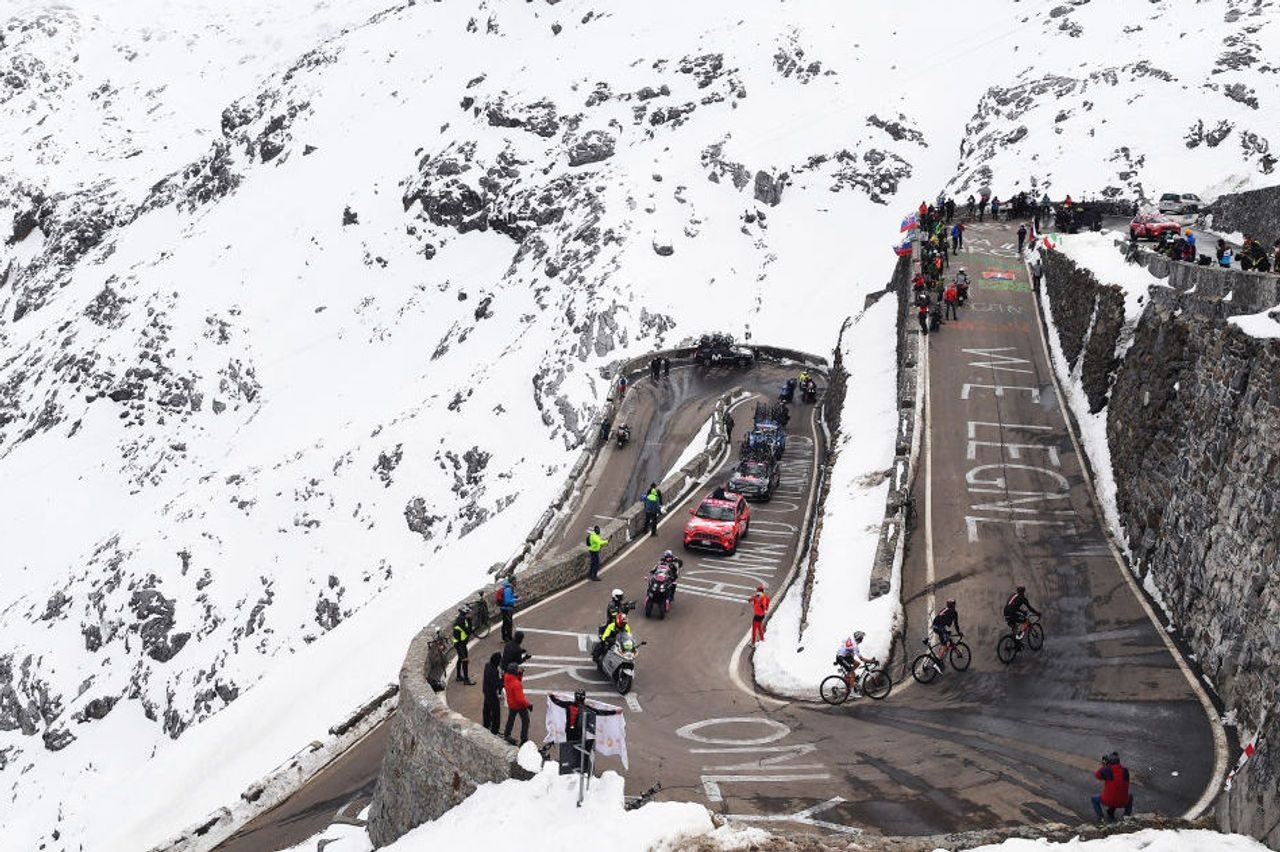







GT.jpg?w=600&auto=format)








